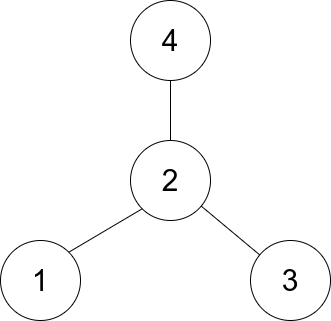There is an undirected star graph consisting of n nodes labeled from 1 to n. A star graph is a graph where there is one center node and exactly n - 1 edges that connect the center node with every other node.
You are given a 2D integer array edges where each edges[i] = [ui, vi] indicates that there is an edge between the nodes ui and vi. Return the center of the given star graph.
Example 1:

Input: edges = [[1,2],[2,3],[4,2]] Output: 2 Explanation: As shown in the figure above, node 2 is connected to every other node, so 2 is the center.
Example 2:
Input: edges = [[1,2],[5,1],[1,3],[1,4]] Output: 1
Constraints:
3 <= n <= 105edges.length == n - 1edges[i].length == 21 <= ui, vi <= nui != vi- The given
edgesrepresent a valid star graph.
Approach 01:
-
C++
-
Python
class Solution {
public:
int findCenter(vector<vector<int>>& edges) {
return edges[0][0] == edges[1][0] || edges[0][0] == edges[1][1] ? edges[0][0]: edges[0][1];
}
};
class Solution:
def findCenter(self, edges: List[List[int]]) -> int:
if edges[0][0] in edges[1]:
return edges[0][0]
return edges[0][1]
Time Complexity
- The function checks a few conditions to determine the center node of the star graph.
- It performs constant-time operations, such as comparisons and assignments.
- Therefore, the time complexity is
O(1).
Space Complexity
- The function does not use any additional space that scales with the size of the input.
- It only uses a few variables to store the intermediate results.
- Therefore, the space complexity is
O(1).